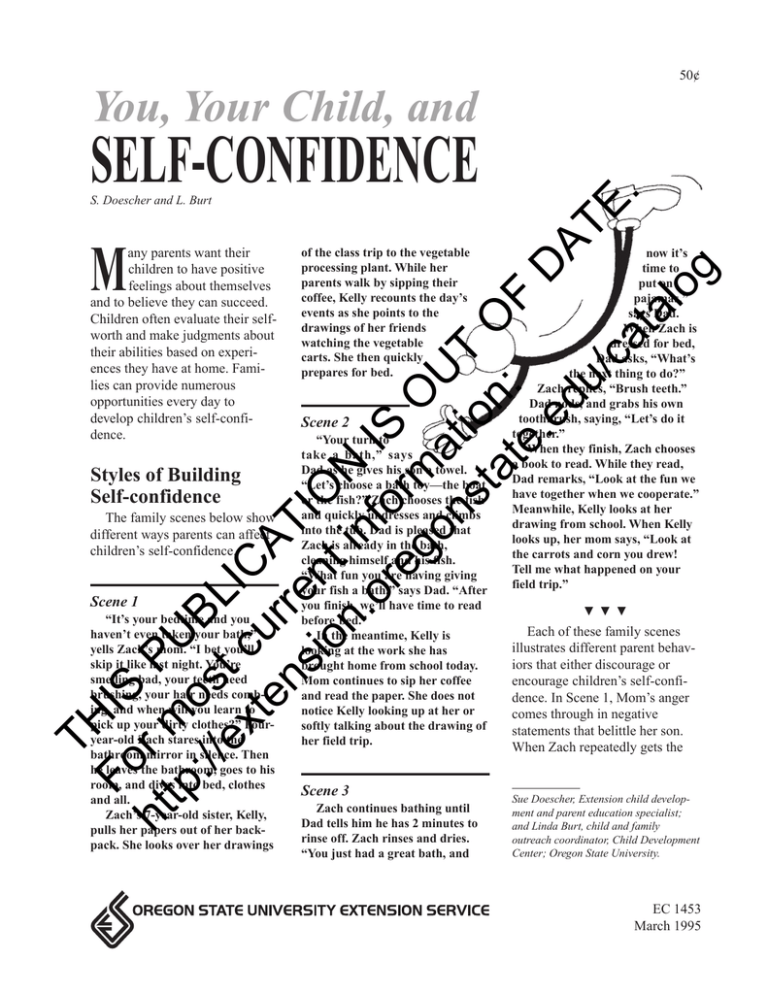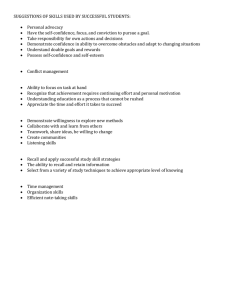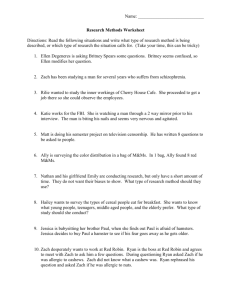SELF-CONFIDENCE M You, Your Child, and
advertisement

50¢ You, Your Child, and Fo IS ht r m P U tp :// os BL ex t c IC te ur A ns re TI io nt ON n. in or fo IS eg rm O on at U st ion T O at : F e. D ed A u/ TE ca . ta lo g SELF-CONFIDENCE S. Doescher and L. Burt M any parents want their children to have positive feelings about themselves and to believe they can succeed. Children often evaluate their selfworth and make judgments about their abilities based on experiences they have at home. Families can provide numerous opportunities every day to develop children’s self-confidence. Styles of Building Self-confidence The family scenes below show different ways parents can affect children’s self-confidence. Scene 1 TH “It’s your bedtime and you haven’t even taken your bath,” yells Zach’s mom. “I bet you’ll skip it like last night. You’re smelling bad, your teeth need brushing, your hair needs combing, and when will you learn to pick up your dirty clothes?” Fouryear-old Zach stares into the bathroom mirror in silence. Then he leaves the bathroom, goes to his room, and dives into bed, clothes and all. Zach’s 7-year-old sister, Kelly, pulls her papers out of her backpack. She looks over her drawings of the class trip to the vegetable processing plant. While her parents walk by sipping their coffee, Kelly recounts the day’s events as she points to the drawings of her friends watching the vegetable carts. She then quickly prepares for bed. Scene 2 “Your turn to take a bath,” says Dad as he gives his son a towel. “Let’s choose a bath toy—the boat or the fish?” Zach chooses the fish and quickly undresses and climbs into the tub. Dad is pleased that Zach is already in the bath, cleaning himself and his fish. “What fun you are having giving your fish a bath,” says Dad. “After you finish, we’ll have time to read before bed.” In the meantime, Kelly is looking at the work she has brought home from school today. Mom continues to sip her coffee and read the paper. She does not notice Kelly looking up at her or softly talking about the drawing of her field trip. Scene 3 Zach continues bathing until Dad tells him he has 2 minutes to rinse off. Zach rinses and dries. “You just had a great bath, and now it’s time to put on pajamas,” says Dad. When Zach is dressed for bed, Dad asks, “What’s the next thing to do?” Zach replies, “Brush teeth.” Dad nods, and grabs his own toothbrush, saying, “Let’s do it together.” When they finish, Zach chooses a book to read. While they read, Dad remarks, “Look at the fun we have together when we cooperate.” Meanwhile, Kelly looks at her drawing from school. When Kelly looks up, her mom says, “Look at the carrots and corn you drew! Tell me what happened on your field trip.” ▼ ▼ ▼ Each of these family scenes illustrates different parent behaviors that either discourage or encourage children’s self-confidence. In Scene 1, Mom’s anger comes through in negative statements that belittle her son. When Zach repeatedly gets the Sue Doescher, Extension child development and parent education specialist; and Linda Burt, child and family outreach coordinator, Child Development Center; Oregon State University. EC 1453 March 1995 Activity 1: Using Positive Responses Many daily situations give parents a chance to increase children’s self-confidence. What would you do in the following examples? First, think about the situation and the parent’s response. Then restate the remarks so that children feel accepted and valued for their contributions. ■ Paulina spills the juice she is pouring. Dad yells, “Now look what you’ve done! I can’t believe this! What a mess!” What would you say differently? Fo IS ht r m P U tp :// os BL ex t c IC te ur A ns re TI io nt ON n. in or fo IS eg rm O on at U st ion T O at : F e. D ed A u/ TE ca . ta lo g message he is helpless and irresponsible, Zach feels he really isn’t capable. With Kelly, her parents ignore her efforts to talk with them. If she is ignored over and over, this can communicate to Kelly that her ideas and experiences don’t matter. Her confidence may be greatly reduced. Some negative behaviors toward children are easy to see. Parents may use commanding statements such as “Get over here!” or “Watch out!” They may make negative comments such as, “Don’t talk with your mouth full” or “You’re too young to come along.” Some negative behaviors are more subtle. Parents may ignore children when they’re too busy or when they don’t hear the children asking for help. Parents may not notice children working cooperatively with others or doing what they’re told to do. Building Children’s Self-confidence TH Respond positively. There are several ways to encourage children’s self-confidence. In Scenes 2 and 3, Dad uses positive statements that build Zach’s feelings of confidence. For example, Dad affirms Zach by saying, “What fun you are having, giving your fish a bath.” Dad directs Zach’s activity when he says, “Your turn to take a bath” and “Let’s choose a bath toy.” Dad offers choices and asks questions of Zach such as, “The boat or the fish?” and “What things do we do next?” ■ Craig leaves his blocks scattered around the rug. Mom orders, “Get over here and clean this up!” What would you say differently? ■ Lindsay throws the puzzle piece down and shouts, “Put this piece in right.” Mom asks, “Can’t you see where it goes? See, put it there.” What would you say differently? ■ Can you think of a situation where you missed a chance to encourage your children’s self-confidence? What did you do and say? What would you do and say differently? In addition, in Scene 3, Mom asks Kelly about her ideas by saying, “Tell me what happened on your field trip.” Since Mom and Dad are responsive to their children, we can imagine that they also use positive unspoken behaviors such as smiles and eye contact as they talk with each other. Look at expectations. Children’s selfconfidence can be influenced by what parents expect. When parents watch and listen, they can be more realistic about children’s abilities and their expectations. A match between what parents expect of their children and what children can really do is critical for encouraging children’s success and self-confidence. How closely do your hopes for your children match what they can do? Typically, preschool-aged children are not expected to perform all the activities listed below. Schoolaged children are more likely to be able to do these things. Do you expect your children to have these skills? Physically ■ Print letters and numbers ■ Sit still ■ Catch a ball ■ Have good balance and coordination Intellectually ■ Focus on an activity for 30 minutes ■ Count to 30 ■ Tell time ■ Tell a story Socially ■ Copy adult behavior ■ Know the rules ■ Play cooperatively in small groups ■ Respond confidently to adults Emotionally ■ Discuss feelings with others ■ Be calm and poised ■ Be sensitive to other’s judgment ■ Care about how others feel Activity 2: Encouraging Self-confidence In the chart below, check how often you see one of your children participate in the following activities: Seldom ■ Sometimes ■ Often ■ Participate in outdoor activities ■ ■ ■ Enjoy active play ■ ■ ■ Show he or she can do intellectual tasks ■ ■ ■ Comment and question in group situations ■ ■ ■ Give suggestions for finishing projects ■ ■ ■ Talk positively about friends ■ ■ ■ Ask others to join in play ■ ■ ■ Work out problems with friends ■ ■ ■ Express feelings ■ ■ ■ Act assured in what she or he says and does ■ ■ ■ Show she or he can do physical tasks TH Fo IS ht r m P U tp :// os BL ex t c IC te ur A ns re TI io nt ON n. in or fo IS eg rm O on at U st ion T O at : F e. D ed A u/ TE ca . ta lo g Sometimes parents have low expectations for their children. This prevents children from developing skills that build selfconfidence. Other times parents have high expectations for their children. These parents may have unrealistic goals for their children and pressure them to perform at an unreasonable level. Look at parenting practices. How do you view and respond to your children? Do you work with your children, not against them? Restrictive parents emphasize strictness and obedience. They frequently correct and punish children and discourage them from exploring their surroundings. Permissive parents demand very little and give their children as much freedom as possible. Children from both of these types of families are less motivated to achieve and less independent. Parents who are warm and loving, yet firm, set reasonable guidelines about what they expect their children to do. This helps children make choices, solve their own problems, and be more sure of themselves. Trusting relationships can be built since children know parents value them and believe in their abilities. As a result, children are likely to feel important, capable, and selfconfident. Provide an accessible, enriched environment. If the home is child-centered, it can give children the opportunity to use their intellectual, social, and physical skills and build selfconfidence. For example, when drawing materials are stored on a low shelf, children can collect and use them without asking. This gives children the chance to be responsible for the materials and help put them away when ■ ■ ■ Encouragement often helps children build self-confidence in a variety of activities such as the ones above. List three ideas you have for helping your child build self-confidence. Pursue what he or she wants to do What you plan to do or say By when (date) 1. 2. 3. they are finished. Book browsing and reading can be promoted if a comfortable area is arranged with good lighting, and favorite books are available. A Note About Praising Well-intentioned parents may be too enthused about their children’s accomplishments and repeatedly praise them for how well they perform. This may result in the children feeling less self-confident since they depend on their parents to judge their abilities. Instead of praising children for what they have done (“Good job!” “Nice helper!”), try recognizing what they are doing (“You’re carrying each plate to the sink very carefully.” “You remembered the silverware needs soaking before it’s washed.”) This helps children focus on building their own confidence in what they are doing, rather than seeking approval and praise for what they have done. Summary Blume, J. (1981). The One in the Middle is the Green Kangaroo. Scarsdale, NY: Bradbury Press. Chevalier, C. (1987). Spence is Small. Nites, IL: A. Whitman. Greenfield, E. (1991). I Make Music. NY: Writers & Readers. State University, Corvallis, 1993). No charge. Helping Children Grow: Developing Social Skills, EC 1317 (Oregon State University, Corvallis, 1993). No charge. Helping Children Grow: Making Children Feel Loved, EC 1319 (Oregon State University, Corvallis, 1993). No charge. Fo IS ht r m P U tp :// os BL ex t c IC te ur A ns re TI io nt ON n. in or fo IS eg rm O on at U st ion T O at : F e. D ed A u/ TE ca . ta lo g Self-confidence is an important part of children’s healthy development. Parents can help children develop confidence in their abilities through daily experiences. This publication has been designed to help you: ■ Consider your behaviors that encourage or discourage children’s self-confidence Books for Young Children ■ Think about your expectations, parenting practices, and home environment that could influence children’s self-confidence ■ Look at your children’s selfconfidence and ways you might promote this behavior. For Further Reading Crary, E. (1992). I’m Proud. Seattle, WA: Parenting Press. Kachenmeister, C. (1989). On Monday When It Rained. Boston, MA: Houghton Mifflin. McPhail, D. (1988). Something Special. NY: Little. Moss, M. (1990). Regina’s Big Mistake. Boston, MA: Houghton Mifflin. Other Publications in this Series You, Your Child, and Problem Solving, EC 1451, by Sue Doescher and Linda Burt (Oregon State University, Corvallis, 1995). 50¢ Cutright, M. (1992). Growing Up Confident: How to Make Your Child’s Early Years Learning Years. NY: Doubleday. You, Your Child, and Positive Discipline, EC 1452, by Sue Doescher and Linda Burt (Oregon State University, Corvallis, 1995). 50¢ Marston, S. (1990). The Magic of Encouragement: Nurturing Your Children and Yourself. NY: Morrow. Related OSU Extension Publications Helping Children Grow: Developing Personal Identity, EC 1293 (Oregon State University, Corvallis, 1992). No charge. Helping Children Grow: Children’s Individuality, EC 1298 (Oregon Ordering Instructions To order copies of the OSU Extension publications listed, or additional copies of this publication, send the amount shown to: Publications Orders Agricultural Communications Oregon State University Administrative Services A422 Corvallis, OR 97331-2119 (503) 737-2513 Fax: (503) 737-0817 You may order up to six nocharge publications without charge. If you request seven or more nocharge publications, include 25 cents for each publication beyond six. We offer discounts on orders of 100 or more copies of a single title. Please call for price quotes. TH Youngs, B.B. (1993). How to Develop Self-Esteem in Your Child: Six Vital Ingredients. NY: Ballantine Books. Helping Children Grow: Encouraging Competence, EC 1321 (Oregon State University, Corvallis, 1993). No charge. See your county Extension home economics agent for additional publications and resources. Extension Service, Oregon State University, Corvallis, Lyla Houglum, interim director. This publication was produced and distributed in furtherance of the Acts of Congress of May 8 and June 30, 1914. Extension work is a cooperative program of Oregon State University, the U.S. Department of Agriculture, and Oregon counties. Oregon State University Extension Service offers educational programs, activities, and materials—without regard to race, color, religion, sex, sexual orientation, national origin, age, marital status, disability, and disabled veteran or Vietnam-era veteran status—as required by Title VI of the Civil Rights Act of 1964, Title IX of the Education Amendments of 1972, and Section 504 of the Rehabilitation Act of 1973. Oregon State University Extension Service is an Equal Opportunity Employer.





